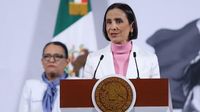The Mexican government has announced a significant investment of 624.618 million pesos (approximately 32.865 million dollars) aimed at achieving electrical self-sufficiency amidst rising protectionism from the United States. This investment, which will be executed during the current administration from 2024 to 2030, encompasses a range of projects in generation, transmission, and distribution as part of a broader strategy presented by President Claudia Sheinbaum last week in response to tariffs imposed by U.S. President Donald Trump.
During a press conference on April 9, 2025, Secretary of Energy Luz Elena González emphasized the critical role of energy in enabling the "Plan México," stating, "Energy is an enabler of the Plan Mexico. If there is energy, it is possible to generate all other rights." This statement underscores the government's commitment to ensuring a reliable and sufficient energy supply as a foundational element for national development.
The bulk of this investment, totaling 427.624 million pesos (22.377 million dollars), will be directed toward generation projects managed by the Federal Electricity Commission (CFE), which aims to add 22.674 megawatts (MW) of capacity. This ambitious plan includes the operationalization of four combined cycle plants and seven hydroelectric plants within the year 2025, alongside bidding for four additional combined cycle plants, one internal combustion plant, and two solar energy facilities.
The initiative also highlights the incorporation of private projects, which are expected to generate over 6,400 megawatts, supplementing the public sector's contribution of more than 22,000 megawatts, primarily focused on clean and renewable energy sources. This approach reflects a broader commitment to sustainable energy development and economic growth.
Looking ahead to 2030, the government has set a goal to construct 158 projects aimed at strengthening the national transmission network, with an investment of 124.524 million pesos (6.156 million dollars). In terms of distribution, plans include building 97 new substations, expanding 95 existing ones, and undertaking 6,875 modernization projects, alongside 42,221 electrification works, with a total investment of 23.409 million pesos (1.225 million dollars).
Furthermore, an investment of 18.916 million pesos (over 935 million dollars) is allocated for 42,221 electrification projects that will benefit 557,817 residents, with the aim of achieving a remarkable 99.99% electrical coverage across the country within the next four years. González explained that the changes in secondary laws and constitutional amendments were aimed at reinforcing energy justice, making it a priority for the Mexican state.
As part of the Plan Mexico, the CFE is also set to initiate tenders for nine new electrical infrastructure projects in key states including Jalisco, Coahuila, Nuevo León, Sinaloa, Chihuahua, Tamaulipas, Baja California, and Guanajuato. These initiatives are expected to alleviate congestion in current electrical networks and enhance supply in regions experiencing high demand.
Among the notable projects already underway are the Central de Ciclo Combinado Salamanca in Guanajuato, inaugurated on March 1, 2025, with an investment of 627.3 million dollars. This facility is projected to benefit 5.8 million inhabitants and has created approximately 2,000 direct jobs. Another significant project is the plant in San Luis Potosí, currently under construction with a budget of 350 million dollars, which is expected to come online in May 2025, serving 2.44 million users.
The El Sauz project in Querétaro is nearing completion with 291.5 million dollars invested, scheduled to conclude in August 2025. Additionally, the Central in Mérida, Yucatán, will provide energy to 730,000 residents, with an expected completion date in October 2025. Hydroelectric projects are also being developed across various states, including Michoacán, Hidalgo, Veracruz, Puebla, and Sinaloa, with investments ranging from 7 to 118 million dollars.
González reiterated that the Plan Mexico reflects a long-term vision aimed at transforming social rights into tangible realities, ensuring access to cleaner, reliable, and affordable energy. This comprehensive strategy combines public investment, infrastructure expansion, and the strengthening of electrical networks, with the overarching goal of fostering economic growth, creating jobs, and meeting energy demands in key development areas.
In summary, the Mexican government's proactive approach to achieving electrical self-sufficiency through the ambitious Plan Mexico not only aims to bolster the nation's energy infrastructure but also positions the country to navigate the challenges posed by external economic pressures. With a focus on sustainability and energy justice, Mexico is setting a course toward a more resilient and equitable energy future.






